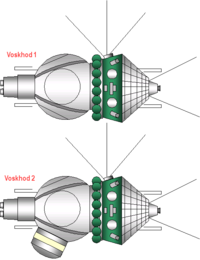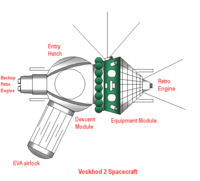Voskhod 1
| Voskhod 1 Восход-1 |
|||||
|---|---|---|---|---|---|
Mission insignia |
|||||
| Mission statistics | |||||
| Mission name | Voskhod 1 Восход-1 |
||||
| Spacecraft type | Voskhod 3KV | ||||
| Spacecraft mass | 5,320 kg (11,700 lb) | ||||
| Crew size | 3 | ||||
| Call sign | Рубин (Rubin - "Ruby") | ||||
| Booster | Voskhod | ||||
| Launch pad | Gagarin's Start, Baikonur Cosmodrome[1] | ||||
| Launch date | 12 October 1964 07:30:01 UTC | ||||
| Landing | 13 October 1964 07:47:04 UTC | ||||
| Mission duration | 1d/00:17:03 | ||||
| Number of orbits | 16 | ||||
| Apogee | 336 km (209 mi) | ||||
| Perigee | 178 km (111 mi) | ||||
| Orbital period | 89.6 min | ||||
| Orbital inclination | 64.7° | ||||
| Related missions | |||||
|
|||||
The flight of the Voskhod 1 (Russian: Восход-1, Ascent 1 or Dawn 1) was the first space flight to carry more than one crewman into outer space, the first space flight without the use of spacesuits, and the first to carry either an engineer or a physician into outer space. The flight of the Voskhod 1 also set a manned spacecraft altitude record of 336 km (209 mi). This Soviet mission was specifically planned to beat the American Gemini program to the milestone of carrying a multiman crew into outer space. As a further propaganda coup, this space capsule was said to have carried a fragment of a communard banner from the Paris Commune of 1871 into orbit.
The three spacesuits for the Voskhod 1 cosmonauts were omitted; there was neither the room nor the payload capacity for the Voskhod to carry them. The original Voskhod had been designed to carry two cosmonauts, but Soviet politicians pushed the Soviet space program into squeezing three cosmonauts into Voskhod 1. The only other space flight in the short Voskhod program, Voskhod 2, carried two suited cosmonauts — of necessity, because it was the flight on which Alexei Leonov made the world's first walk in space.
Contents |
Cosmonauts
| Position | Cosmonaut | |
|---|---|---|
| Command Pilot | Vladimir Komarov First spaceflight |
|
| Engineer | Konstantin Feoktistov First spaceflight |
|
| Medical Doctor | Boris Yegorov First spaceflight |
|
Back-up crew
| Position | Cosmonaut | |
|---|---|---|
| Command Pilot | Boris Volynov | |
| Engineer | Georgi Katys | |
| Medical Doctor | Aleksei Sorokin | |
Reserve Cosmonaut
| Position | Cosmonaut | |
|---|---|---|
| Medical Doctor | Vasili Lazarev | |
Mission parameters
- Mass: 5,320 kg (11,700 lb)
- Perigee: 178 km (111 mi)
- Apogee: 336 km (209 mi)
- Inclination: 64.7°
- Period: 89.6 min
Background

The original prime crew of cosmonauts for Voskhod 1, composed of Boris Volynov, Georgi Katys, and Boris Yegorov, was rejected just three days before the scheduled launch date for the space capsule, reportedly due to the State Commission's discovery that Volynov's mother was Jewish.[2]
There was also some controversy between the Soviet Air Force, which wanted an all-pilot space crew, and the Soviet (civilian) Chief Designer, Sergey Korolyov, who wanted to send non-military crewmen into outer space. Konstantin Feoktistov, who had been a design engineer for the Vostok, Voskhod, and Soyuz programs, was selected for this flight (and became the only Soviet outer space designer to make a spaceflight), while Boris Yegorov, a medical doctor, used his political influence to get selected for the crew through his father's Politburo connections.
Mission highlights

The Voskhod spacecraft were basically Vostok spacecraft with a backup, solid-fuel retro-rocket added onto the top of the descent module. The ejection seat was removed and three crew couches were added to the interior at a 90-degree angle to that of the Vostok cosmonaut's position. There was no provision for escape for the crewmen in the event of a launching or landing emergency. A solid-fuel braking rocket was also added to the space capsule's parachute lines to provide for a softer landing at touchdown. This was necessary because, unlike the Vostok space capsule, no ejection seats were fitted in the Voskhod; the cosmonauts had to land inside the Voskhod descent module.
Much of the mission of Voskhod 1 was devoted to biomedical research, and to the study of how a multi-disciplinary team could work together in space. The mission was short, at only slightly over 24 hours. Incidentally, the Soviet Premier Nikita Khrushchev was removed from power during the spaceflight, and it has been speculated that this led to the mission being cut short.[3] However, the cramped conditions of the Voskhod space capsule has also been suggested as a factor ruling out a longer-duration spaceflight.
Happening as it did before the beginning of the Project Gemini two-man flights, Voskhod 1 had a significant, but temporary, international impact. The NASA Administrator, James E. Webb, called the flight of Voskhod 1 a "significant space accomplishment" adding that it was "a clear indication that the Russians are continuing a large space program for the achievement of national power and prestige."[4]
References
- ↑ "Baikonur LC1". Encyclopedia Astronautica. http://www.astronautix.com/sites/baiurlc1.htm. Retrieved 2009-03-30.
- ↑ French, Francis; Colin Burgess, Walter Cunningham (2007). In the Shadow of the Moon. University of Nebraska Press. pp. 253–254. ISBN 0803211287.
- ↑ An example appears in the Times obituary of Feoktistov: [1]
- ↑ Encyclopedia Astronautica, Voskhod 1
- "Voskhod 1". Encyclopedia Astronautica. http://www.astronautix.com/flights/voskhod1.htm. Retrieved 2008-08-10.
|
|||||||||||||
|
|||||||||||
|
||||||||
